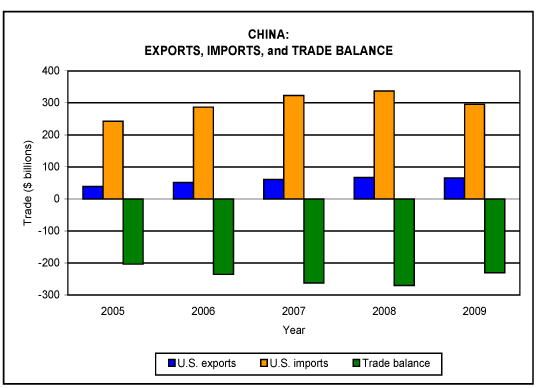View Section in Publication :: Return to Overview

Key Economic Trends
- In 2009, the U.S. trade deficit with China decreased by $39.9 billion (15 percent) to $230.4 billion. The decline in U.S. imports from China (13 percent) exceeded the decline in U.S. exports to China (3 percent). China remains the single-leading source of U.S. imports and the third-largest market for U.S. exports.
- The electronics products and machinery sectors accounted for the largest share (by value) of the U.S. export decrease. Increased U.S. exports of agricultural products (mainly oilseeds), forest products, and chemicals to China mitigated the fall in exports.
- The $2.0 billion decrease in U.S. exports to China was a function of the slowdown in Chinese economic growth. China's GDP growth slowed to 8.7 percent in 2009, after having maintained a 10 percent average for the last two decades. Global recessionary pressures reduced demand for China's manufactured exports, an important driver of the Chinese economy, which in turn reduced demand in China for imported inputs of all types.
- U.S. import declines from China, totaling $42.0 billion in 2009, were mainly in steel mill products; consumer products such as furniture, games, and luggage; and computers and consumer electronics.
Trade Shifts from 2008 to 2009
- U.S. trade deficit: Decreased by $39.9 billion (15 percent) to $230.4 billion
- U.S. exports: Decreased by $2.0 billion (3 percent) to $65.1 billion
- U.S. imports: Decreased by $42.0 billion (12 percent) to $295.5 billion
Other Government Resources
U.S. Central Intelligence Agency: World Factbook - China
World Trade Organization: Trade Policy Review - China
Peoples Republic of China
U.S. Department of Commerce
